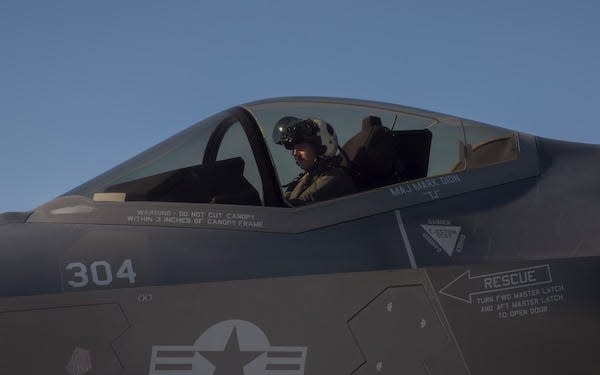Fighter pilot from the Marine Corps' first F-35C squadron says the stealth jet is making US aircraft carriers more lethal

The US Navy's first F-35C fighter-jet squadron deployed on an aircraft carrier early last month.
The first Marine F-35C squadron is working up to its carrier deployment, expected in early 2022.
A Marine pilot in the squadron talked to Insider about what the stealth jet means for US carriers.
US Navy aircraft carriers have started deploying with F-35C stealth fighter jets, aircraft that one fighter pilot called "a game changer" and said are making US carriers even more lethal.
The first US Navy aircraft carrier to deploy with F-35C Lightning II Joint Strike Fighters, the variant engineered for carrier operations, was USS Carl Vinson, which departed San Diego last month and sailed through the South China Sea recently with the "Argonauts" of Strike Fighter Squadron, or VFA, 147, the Navy's first F-35C squadron, on board.
The Marines are in the game as well. The "Black Knights" of Marine Fighter Attack Squadron, or VMFA, 314, the Corps' first F-35C squadron, achieved full operational capability in July and are now preparing for their first carrier deployment.
This squadron is working long hours training as part of Carrier Air Wing 9 aboard USS Abraham Lincoln and at Naval Air Station Fallon in Nevada, home of TOPGUN, the Navy's elite air-combat school, to get ready for the deployment expected to start early next year.
The F-35, the most expensive weapons program in US military history, has had its share of setbacks in development. But pilots are still excited about what the aircraft can do, one of the "Black Knights" told Insider.

'This is where I want to be'
Maj. Mark Dion, an operations officer and VMFA 314 pilot, transitioned to the F-35 from the F/A-18 Super Hornet, and he told Insider recently that the fifth-generation fighter is definitely what he wants to be flying. He said that "the F-35C is far and away more capable than the F/A-18" Hornet.
"This jet gives you so much more situational awareness," he said. "The fusion of all these sensors the jet has just gives the pilots so much more information to make decisions, make better decisions, make them quicker, and just be more lethal."
"If we are doing an intercept out there, the F-35 is what you want to be in," he said.
"It gives me that ability to kind of remain undetected, or at least the ability to remain where the enemy cannot necessarily employ their weapons against me, which we didn't really have back in the F/A-18s, those fourth-gen aircraft," Dion said. "That's a massive advantage of this jet."
"If we find ourselves going to a merge with an enemy fighter, it does well in that close combat," he said, adding that "it does very well. I would rather be in the F-35. I have flown both, and this is where I want to be."

'It just makes the carrier much more lethal'
Dion has also flown the F-35B, a short takeoff and vertical-landing variant for the Marine Corps that can fight from airstrips and amphibious assault ships. He was part of the first US F-35 combat deployment, which saw Marine pilots flying F-35Bs off the USS Essex and conducting strikes in Afghanistan.
"That was amazing," he told Insider, saying that it is something he'll always remember.
"That was huge, just being kind of the first ones out there, leading the way with the Marine Corps," said Dion, who is now out front on the Corps' efforts to field an F-35C squadron.
Asked whether he preferred the Hornet, the F-35B, or the F-35C, Dion said that his favorite aircraft was the C.
The major said the F-35C "brings a lot more capability" than the B. It has more fuel, allowing for more time on station and the ability to carry different weapons.
"The jet brings a lot of capability to the Marine Corps and to the Navy," he said, "and to have an F-35 squadron on a carrier integrated with F/A-18s and the tactics we have with those F/A-18s, it just makes the carrier much more lethal."
For example, data links allow the carrier air wing to fight as a single force. In combat, the F-35 can get a better read on the battlefield and then relay targeting information to the F/A-18s, which have a more robust missile loadout than their fifth-gen counterparts. Each aircraft enhances the combat power of the other.
Dion described the F-35's ability to enhance the carrier air wing, project power, evade higher-end threats, and mitigate near-peer assets as "a game changer."

'A lot of hard work and sacrifice'
VMFA 314 received its first F-35C on January 21, 2020, achieved initial operational capability in December, and was fully operational by this past summer.
"The Marines of VMFA 314 have worked their tails off for the past two years to build a squadron of the best DoD air asset that we have, to build the squadron up with that jet, to be ready to go to combat if necessary within a very short period of time," Dion said, referring to the Department of Defense.
The major said it's been "a lot of hard work and sacrifice," but "the hard work that they put into the last two years has really allowed us to be here where we are at right now and continue to be successful and to eventually, early next year, deploy and be ready to defend the nation."
"It's been amazing," he said. "It's pretty awesome to be a part of that and see that."
Read the original article on Business Insider

